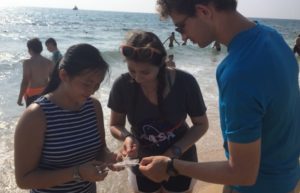By Rachel Landman, Assistant Director of URJ 6 Points Sci-Tech Academy
Water is essential to human life and Israel is more than 60% desert. During the years the State of Israel was being established, pioneers faced the challenge of creating a self-sufficient society in an environment without easy access to food or water.
The answer? Innovation.
Most of the pioneers who arrived in Israel during the many aliyot (waves of immigration) leading up to 1948 were not the Nobel laureates, scientists, engineers, or entrepreneurs who make up Israeli society today. During the early aliyot, many of the pioneers were teens and young adults with few skills and little experience who found themselves in a land with little water and few natural resources. With little to lose, they took risks to test hypotheses and ideas, building a culture that values innovation and entrepreneurship.
During my trip last summer – my seventh to Israel – I saw, for the first time, the network of scientists, researchers, and entrepreneurs, that has supported Israel’s culture of innovation in the last 70 years. Leading the URJ’s inaugural Sci-Tech Israel trip for high school students, I gained a new interest in and understanding of how innovation intersects with the country’s modern history.

As students examined water resources – testing the temperature and pH levels at sites around the country – and learned about innovative technologies for conservation and reclamation, we also focused on how Jewish values, including netzach (perseverance), are infused into the science and tech culture of Israel. Such values are critical in fostering the technology and entrepreneurship necessary to provide water in a desert region.
Since ancient times, we have been aware of the lack of water in Israel. In Deuteronomy 11:10-11, God warns the Israelites:
For the land that you are about to enter and possess is not like the land of Egypt from which you have come. There the grain you sowed had to be watered by your own labors, like a vegetable garden; but the land you are about to cross into and possess, a land of hills and valleys, soaks up its water from the rains of heaven.
In such an arid climate, Israelis could not farm using only the limited amounts of rain that fell during the winter months. Rather than giving up the prospect of farming in the desert, they had to be inventive about both water and crops.
Thus, in 1953 construction began on the National Water Carrier of Israel, designed to transport water from the Galilee to the center of the country, reaching the northernmost parts of the Negev. At the time, 80% of the water was diverted for agriculture, and 20% for drinking. As Israel’s population grew and the country developed new technologies for water conservation and reclamation, a greater percentage of water from the National Water Carrier was designated for drinking water.
In addition to bringing water to the Negev region, farmers and researchers needed to identify and develop crops that could thrive in the harsh desert conditions. Universities such as the Weizmann Institute of Science, founded in the early 1900s, have long focused research efforts on modifying fruits and vegetables, so they can grow in the desert. In the 1950s, Weizmann Professor Esra Galun, z’l, developed a hybrid cucumber that was disease resistant and could be mechanically harvested. A staple of Israeli salad, this cucumber is now a major player in Israeli markets and throughout the Middle East.
Today, Israel continues to build upon these and other innovations from its first decade. Demonstrating the Jewish value of shomrei adamah (keepers of the earth), researchers are developing more environmentally sustainable crop production and water distribution methods. The shift away from using the National Water Carrier of Israel to divert water from the Sea of Galilee toward water reclamation and desalination, for example, helps protect the precious natural resources the Galilee’s water supports.
Israel’s commitment to science and technology precedes the birth of the state in 1948 and continues unabated today. Top scientists and institutions continue to place Israel in a prominent position in the international science and technology community, initiating and contributing to revolutionary research in areas from computer science and cancer to biomedical innovation and environmental sustainability, and more.
This post is the first of seven designed to inform and inspire readers about scientific and technological advances in modern Israel in each of the decades since its founding in 1948.
Sci-Tech Israel, the newest program in the Union for Reform Judaism’s suite of Israel experiences, offers opportunities for Jewish teens to explore Israel through a lens of science, technology, and innovation. Visit nftyisrael.org to learn more about teen travel to Israel.
This post originally appeared on the blog of ReformJudaism.org
